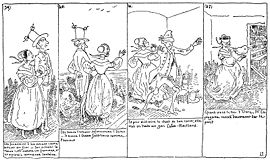Julia Draft 2
From DigitalRhetoricCollaborative
|
Webcomics, or digital comics, is the name given to comics posted on the internet and are serial in nature. A portion of webcomics are simply a remediation, or digital version, of a preexisting comic. Companies like Marvel and DC often offer their printed comics online to consumers. Other webcomics are made solely with the web in mind. They may be made using more traditional materials, such as pen and ink, and then uploaded online. Most are created digitally with software like Photoshop and found exclusively on the web. The digital format gives artists more freedom and allows them to experiment with unconventional styles and forms that would otherwise be impossible in a physical format. Unlike print comics, almost anyone can create a webcomic. The creators rarely have to worry about obstacles such as publishers or censorship due to the more democratic nature of the internet. If the webcomic enjoys enough success, the creators may offer a print version of these comics in order to make a profit. Most webcomics do not get this popular.
[edit] History
[edit] Print comics
The webcomic was preceded by and greatly influenced by the print comic. Many of the conventions of comics are credited to the Swiss Rodolphe Töpffer, who created what were known as some of the earliest European comics in the mid 1800s and is known as "the father of the modern comic".[1] He is particularly well known for his 1837 Histoire de M. Vieux Bois, published in English as The Adventures of Obadiah Oldbuck, which is considered to be one of the first comic books.[2] Many of his publications, including Histoire de M. Vieux Bois, featured pages full of captioned panels. Each page would contain between one and six sequential panels coupled with text that would tell a story. This form would later become the standard for the more familiar modern print comic.
Comics specifically in America became popularized in the 1920s, with humorous newspaper strips and comics such as The Adventures of Tintin. The superhero genre began in June 1983 with the introduction of Superman in the first issue of Action Comics. [3] The Second World War saw an influx of superhero and narrative comics. [4] Since then, the medium has spread and received more critical attention. The popularity has only grown with the introduction of the internet as a new platform to create and host comics.
[edit] Early webcomics
Early webcomics often sought to follow the traditional formats of print comics.
Eric Millikin distributed the first known webcomic Witches and Stitches, a parody of The Wizard of Oz, in 1985 through CompuServe, the first major online service provider in the United States.[5] CompuServe allowed Millikin to self-publish his webcomic and bypass censorship. The limited nature of the internet at the time, however, made his audience very small and hindered the webcomic's distribution.[6] Threats of lawsuits for the unauthorized use of copyrighted material forced Millikin to take down the webcomic.[7]
In 1991 Hans Bjordahl published Where the Buffalo Roam on USENET and FTP and touted it as the “First Comic on the Internet”.[8] The comic originally started in a school newspaper in 1987 and was based on Bjordahl's college life at the The University of Colorado at Boulder.[9] It migrated to the Web in 1993 after the advent of the Mosaic browser and ran until 1995.
Doctor Fun by David Farley was the first comic published on the Web.[10] It was made up of a series of one-panel gags that ran from September 24, 1993 to June 9, 2006. The comic gained enough popularity that it was acknowledged by the Mosaic web browser creators as "a major breakthrough for the Web".[11]
[edit] Notable webcomics
Webcomics became increasingly popular in the early 2000s as creators realized that they could make a profit off of their work.[12] Webcomics started gathering large followings as internet use became more standard and available. Artists increasingly began to experiment with the webcomic form after Reinventing Comics was published and new digital tools and technology became available.[13][14] A few notable and influential examples are gathered here.
- Penny Arcade was first published online in 1998 on looneygames.[15] It has since migrated to its own website, where it continues to run as one of the most popular webcomics today. The comic strips are illustrated by Mike Krahulik and written by Jerry Holkins and features their alter egos John "Gabe" Gabriel and Tycho Brahe, respectively. Like many internet comics, Penny Arcade focuses on gaming culture, commentary, and humor. There is no continuous plot. The webcomic has enjoyed enough popularity to spawn its own print collections, merchandise, podcast, video game, and an annual gaming convention, known as PAX. Both Krahulik and Holkins are successful enough to make a living off of the webcomic, while still regularly donating charity and supporting a staff. [16]
- 8-Bit Theater is a completed webcomic created by Brian Clevinger from March 2, 2001 to June 1, 2010. [17] The comic tells a story with an ongoing plot and multiple reoccurring characters. It frequently parodies role-playing video game stereotypes. Unlike many other digital comics, 8-Bit Theater is not mostly hand drawn. It almost solely uses pixel graphics. The webcomic samples and remixes art from existing video games, such as the Final Fantasy series.
- xkcd is written by Randall Munroe and began publishing regularly online in 2006. It is described by the creator as "a webcomic of romance, sarcasm, math, and language". [18] The comic mainly features geek humor, especially math or science jokes. Many of the entries are written as a comic strip or single-panel gag featuring solely stick figures. It became known as one of the more popular webcomics. Munroe works on the comic fulltime, making xkcd one of the few webcomic creators successful enough to make a living off of it. [19] A number of his comics test the limits of the form on the internet. They may experiment with how the mouseover text, panel size, and IP addresses enhance the experience of reading the comic. [20][21][22]
[edit] Formats and styles
A portion of comics found on the web are simply a remediation of print comics. Major comic book publishers, such as Marvel and DC Comics, often host their issues online. Access is generally granted after buying individual issues or paying for a subscription. The jump to digital formats by major publishing companies occurred after other sites, such as Newsarama and ComicMix, showed success. Marvel, for example, did not being producing digital subscriptions until November 13, 2007. [23]
Webcomics may follow more traditional styles, such as the one-panel gag, editorial cartoon, newspaper strip, or comic page. Many still adhere to such standards. These formats make the transition from digital to print much easier for creators who decide to publish and sell collections of their work. Those published in a nonstandard format may experience trouble when transferring the comic onto a page.
The digital format also allows for nontraditional styles and experiments. The internet allows creators to move away from pagination onto what Scott McCloud calls the “infinite canvas”. [24] With the infinite canvas, online comics can theoretically extend indefinitely without running into the constraints of page sizes that print comics must adhere to and face. Some digital comics make full use of this idea, such as xkcd’s “Click and Drag”. Munroe’s comic likewise demonstrates how digital comics might utilize user-directed nonlinear storytelling.
Multimedia and multimodal forms have emerged that make full use of the possibilities offered by the web. Comics may integrate or add extra material including audio files, videos, bios, and gifs alongside the graphics. These forms may greatly increase the amount information and user interactivity, but may also run the “risk of distracting [readers] from their immersive involvement with the main narrative”. [25]
The increasing use of multimedia and nontraditional forms in webcomics has caused some debate about what exactly distinguishes a comic from other media, such as videos or animation. Writer Daniel Goodbrey suggests that it is the reader’s active role, their control in pacing the story, which makes the difference.
[edit] Success and publishing
The internet had democratized and globalized comic creation, allowing almost anyone to post their creations online. Writers are not as constrained by publishers, printing, or commissioners on the web as they are offline. Production is usually low-cost and free of censorship, and access to the comics is easily obtainable. However, few ever enjoy financial success.
Comic creators may try to make a profit by offering subscription-based services. They may also use crowdfunding platforms such as Kickstarter to fund their projects and goals. If the comic enjoys enough success, the writer may offer a print collection. Even if the full comic is available online for free, “plenty of readers still want to own it in a tangible printed edition” [26].
Awards.
[edit] References
- ↑ McCloud, Scott. Understanding Comics: The Invisible Art. New York: HarperPerennial, 1994. Print.
- ↑ "The Adventures of Obadiah Oldbuck." Don Markstein's Toonopedia: Mr. Obadiah Oldbuck. N.p., n.d. Web. 19 Apr. 2015.
- ↑ Lente, Fred, and Ryan Dunlavey. The Comic Book History of Comics. San Diego: IDW, 2012. Print.
- ↑ Duncan, Randy, and Matthew J. Smith. The Power of Comics: History, Form and Culture. New York: Continuum, 2009. Print.
- ↑ Garrity, Shaenon. “The History of Webcomics | The Comics Journal.” http://www.tcj.com/the-history-of-webcomics/ Web. 15 Apr. 2015.
- ↑ Booker, M. Keith. Comics through Time: A History of Icons, Idols, and Ideas. N.p.: n.p., n.d. Print.
- ↑ Leigh, Megan. "Webcomics: From printed comic strips to digital." http://pop-verse.com/2014/02/19/webcomics-from-printed-comic-strips-to-digital/
- ↑ Bjordahl, Hans.“Where the Buffalo Roam | The Internet’s First Comic Strip | First What?” http://www.shadowculture.com/wtbr/site.html Web. 15 Apr. 2015.
- ↑ Booker, M. Keith. Comics through Time: A History of Icons, Idols, and Ideas. N.p.: n.p., n.d. Print.
- ↑ Garrity, Shaenon. “The History of Webcomics | The Comics Journal.” http://www.tcj.com/the-history-of-webcomics/ Web. 15 Apr. 2015.
- ↑ “What’s New! September 1993.” http://home.mcom.com/home/whatsnew/whats_new_0993.html N.p., n.d. Web. 15 Apr. 2015.
- ↑ Garrity, Shaenon. “The History of Webcomics | The Comics Journal.” http://www.tcj.com/the-history-of-webcomics/ Web. 15 Apr. 2015.
- ↑ Garrity, Shaenon. “The History of Webcomics | The Comics Journal.” http://www.tcj.com/the-history-of-webcomics/ Web. 15 Apr. 2015.
- ↑ McCloud, Scott. Reinventing Comics:. New York: Perennial, 2000. Print.
- ↑ Krahulik, Michael & Parkinson, Jerry. http://www.loonygames.com/content/1.13/pa/ November 1998.
- ↑ MacDonald, Heidi (December 19, 2005). "Web Comics: Page Clickers to Page Turners; It's like manga five or six years ago". http://www.publishersweekly.com/pw/print/20051219/35322-web-comics-page-clickers-to-page-turners.html
- ↑ Clevinger, Brian. "Ta-daaaa!" http://www.nuklearpower.com/2010/06/01/ta-daaaa/
- ↑ Munroe, Randall. https://xkcd.com
- ↑ Cohen, Noam. "This is Funny Only if You Know Unix". http://www.nytimes.com/2008/05/26/business/media/26link.html?partner=rssnyt&emc=rss&_r=0
- ↑ Robinson, Tasha. "Check out XKCD’s epic multi-day animation comic". http://www.avclub.com/article/check-outem-xkcdems-epic-multi-day-animation-comic-95486
- ↑ Plafke, James. "Everything You Need to Know About Today’s xkcd Comic, “Click and Drag”". http://www.themarysue.com/xkcd-click-and-drag-comic/
- ↑ http://forums.xkcd.com/viewtopic.php?t=82442
- ↑ Wershler, Darren. “Digital Comics, Circulation, and the Importance of Being Eric Sluis.” Cinema Journal 50.3 (2011): 127–134. Print.
- ↑ McCloud, Scott. Reinventing Comics:. New York: Perennial, 2000. Print.
- ↑ Gravett, Paul. Comics Art. New Haven, CT: Yale UP, 2013. Print.
- ↑ Gravett, Paul. Comics Art. New Haven, CT: Yale UP, 2013. Print.


